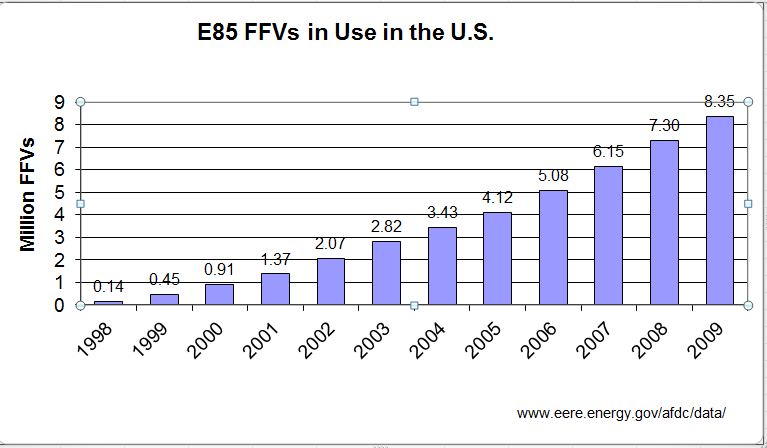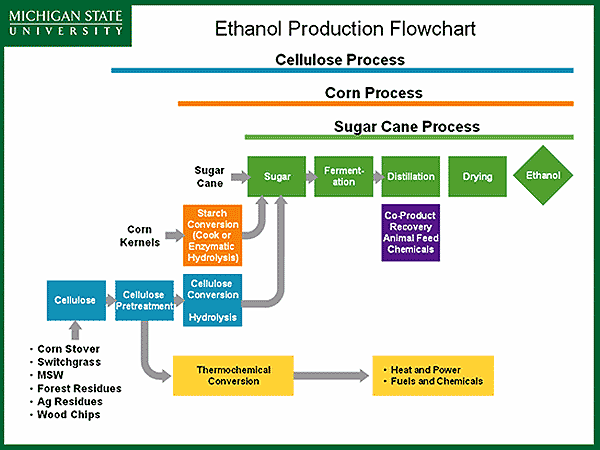Biodiesel:
Biodiesel is a domestically produced, renewable fuel
that can be manufactured from vegetable oils,
animal fats, or recycled restaurant greases.
Highest yields come from:
It takes about 7.3 pounds of
soybean oil, which costs about 20 cents per pound,
to produce a gallon of biodiesel. Feedstock costs
alone, therefore, are at least $1.50 per gallon of soy
biodiesel.
Total possible yield:
- There are about 360 million acres of useable crop land in the US.
- One acre of land produces an average of 40 bushels of soybeans.
- Each bushel of soybeans can produce about 1.5 gallons of soybean oil.
- Efficiency of conversion of soybean oil to right chemical formula for
fuel in an engine: about 80%
Multiplying everything together gets you 18 billion gallons a year (remember
we need 150) and this would require all crop land devoted to growing fuel
and not food for a resultant 12% market penetration.
Electricity (e.g. Plugin Hybrid Electric Vehicles - PHEV)
A brief primer on important numbers:
- You will see numbers ranging from 33 to 37 KWH energy equivalent to a gallon of gasoline.
The variation is related to whether you do the calculation by mass or by volume since the
volume of gallon of gas is temperature dependent. In round numbers there are 35 KWH per gallon of
gas.
- Suppose average fuel economy rises to 35 miles per gallon (for a 3000 lb car)
 This is
then equivalent to 1 KWH per mile energy cost. This is a useful number to know.
This is
then equivalent to 1 KWH per mile energy cost. This is a useful number to know.
- But, an electric motor is about 2.8 times more efficient than an ICE and therefore
the per mile electricity cost equivalent is about 0.35 KWH per mile.
- A lithium-ion battery pack stores an average of 140 watt hours per kg. Typical laptop battery
weighs about 1 kg and average laptop power consumption is about 40 watts. This means
your laptop battery lasts for 140 watt hours/40 watts = 3.5 hours. At peak power your laptop
likely consumes 80 watts and so the battery lifetime would he halved.
- Suppose you want 100 mile free range (such as the Nissan leaf "claims") on your lithium-ion
battery pack. @0.35 KWH per mile you would then need to store 35 KWH of electricity: @140
watt hours per kg (.14 KWH per kg) you would need 35/.14 = 250 kg (550 lb) battery pack -
a significant fraction of total vehicle weight (note that 3 gallons of gas weighs 19.5 lbs).
- A typical 0.5 kg laptop battery costs about 80$ - therefore 250 kg costs $10K
- Now let's remember ohms law. Power = VxI. A typical household standard 120V outlet has
a current rating of about 15 amps.
- 15 amps x 120 volts = 1.8 KW or 1.8 KWH per hour of charging
- Typical charging efficiency for PHEV is 85%
- To charge battery to 35 KWH from 120 volt source then requires 41 KWH to be delivered.
- @rate of 1.8 KWH per hour then this would take 41/1.8 = 22.8 Hours
- To charge "overnight" requires special circuitry installed - similar to a dryer circuit which
is 20 amps @220 volts of 4.4 KWH per hour thus reducing charging time by 1.8/4.4 or 9 hours ...
So there are three main problems associated with scaling up PHEVs to reduce overall
gas consumption.
1. Energy density storage of batteries is still insufficient relative to american long
distance driving habits (much research is going into making for efficient batteries and
we will discuss energy storage later in this course).
2. There is a real potential problem with the lithium-ion supply chain ( which
causes significant scalability problems ) if there is a sudden
need for mass production of 500 lb lithium-ion battery packs.
3. The price of the battery pack raises the price of the vehicle significantly. (You can buy
3 Toyota Yaris's for the price of 1 Chevy Volt)
Grain-Based Ethanol:
Ethanol is an alcohol-based alternative fuel
produced by fermenting and distilling starch crops
that have been converted into simple sugars.
Feedstocks for this fuel include corn, barley, and
wheat
Today's commercially available vehicles that can use
E85 (85% Ethanol and 15% gasoline) are called
flexible fuel vehicles (or FFVs), meaning that they
can run on E85, gasoline, or any mixture of the two.
About 10-12 million (our of 300-500 million)
FFVs have already been sold in the
United States.

Most of the current E-85 fueling stations are located
in the mid-west; however, there are approximately
1600 E-85 fueling stations across the country. In the case of Shell oil,
you will get 10% ethanol whether your want it or not.
Sequential BioFuels is located in
Eugene and is a local distributor of biodiesel and grain ethanol fuels.
But grain based ethanol is simply not scalable (as will be
shown shortly)
Fuel Cells:
- Hydrogen production comes from stranded renewables (i.e. wind energy in the
Aleutian Islands) or maybe from new NG sources.
- Honda FCX is a real car
- Hydrogen has higher energy density than gasoline so no performance issues at all.
- Current limiting factor on scalability is the required platinum catalyst as previously
explained.
Cellulostic BioFuels. This may have large potential:
- Conventional ethanol is derived from grains such as corn and wheat or soybeans.
This has somewhat limited yield per unit acre of crops grown.
- Cellulosic ethanol can be produced from a wider variety of cellulosic biomass feedstocks including agricultural plant wastes (corn stover, cereal straws, sugarcane bagasse), plant wastes from industrial processes (sawdust, paper pulp) and energy crops grown specifically for fuel production, such as switchgrass
Overall Ethanol Production Scheme

Notes:
- large scale biomass production for alternative fuels potentially creates
a lot of jobs
- The major technical/scientific problem is sugar extraction with reasonable efficiency.
This is why Sugar Cane is the best feedstock (e.g. Brazil). The current efficiency from
converting pretreated cellulosic material into sugar is very low. With R&D investment,
this can increase and it has to in order to cellulosic ethanol to become a serious fuel source.
Natural Gas: Potentially feasible if the cost of electricity associated with compressing
the gas for storage in a vehicle is reasonable.
Developing a comparative index. The higher the number the better.
AFI = Fuels Index:
- Alternative Fuels Index (AFI) = weights P and G
- Renewable Fuels Index (RFI) = weights F and G
G = percentage reduction in greenhouse gas emissions; common to both indexes
P = percentage reduction in actual petroleum use. This is what "alternative" means. Alternatives
to petroleum
F = percentage change in total fossil fuel usage (including fossil energy/electicity to make
the fuel).

Clear winners are:
- Hydrogen from stranded renewables (this is equivalent to H with all C sequestered)
- E85 from cullulostic sources (not achieveable yet)
 This is
then equivalent to 1 KWH per mile energy cost. This is a useful number to know.
This is
then equivalent to 1 KWH per mile energy cost. This is a useful number to know.

